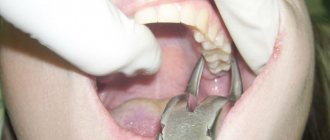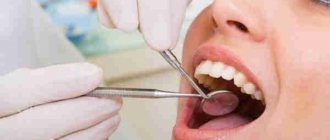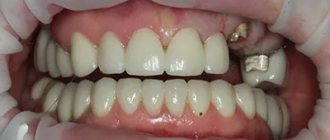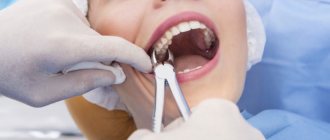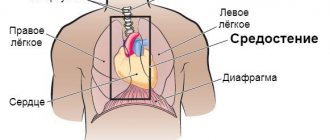How is a tooth root removed from above and below in a dental clinic? Before the procedure, it is necessary to go through a mandatory preparatory stage, which ensures the success of subsequent surgical procedures.
Since a drill and other special instruments are used for extraction, some patients experience complications, but the likelihood of them occurring is very low if the dental unit was removed by an experienced specialist. When a person tries to remove debris on his own at home, this can lead to serious health problems that are life-threatening.
When is tooth root removal required?
Dentists prefer to resort to such radical methods as rarely as possible and try to keep the dentition “alive.” Even if a small fragment remains, the possibility of prosthetics using the preserved base is first considered. In some cases, extraction cannot be done without.
Indications:
- The patient is diagnosed with periodontitis in the later stages, when the root part is severely loosened;
- serious injury (fracture);
- a cystic neoplasm has been discovered that cannot be eliminated in isolation;
- a piece of the crown broke off, extending deep into the gum tissue;
- solid particles remained after poor-quality doctor intervention.
How is a tooth root removed in dentistry in children? Is this necessary? Milk units normally fall out on their own. They are indicated to be pulled out in cases of deep carious lesions, fractures, loosening and subgingival caries.
What happens if you leave
Some people can walk for several years with their teeth completely destroyed. This is very harmful, because the remaining root part rots and is a source of foul odor from the mouth. In addition, this is a hotbed of numerous infections, because the roots accumulate pathogenic microorganisms and food particles. Dense plaque and tartar form on the fragments. As a result, soft tissues become inflamed.
The body will constantly fight the source of the problem; the immune system will direct a significant part of its resources to the fight. Sooner or later, a severe inflammatory process develops; in the most severe cases, the maxillary sinuses become infected, osteomyelitis develops, and fractures and other injuries are possible.
Patients mistakenly believe that over time the root will come out on its own, so dental intervention is not necessary. The root part does not fall out, over time it will become overgrown, and the doctor will have to cut the gum for high-quality extraction. In this case, the rehabilitation period may be delayed.
DentErum
To eliminate the possibility of complications, upon completion of the tooth extraction procedure, the doctor performs hemostasis and provides detailed instructions to the patient on further care of the surgical area. Our doctors prefer to inject a special osteotropic material containing a complex of antibiotics into the socket. Sometimes a suture is required. In this case, healing proceeds painlessly and very quickly. Therefore, even if tooth extraction was carried out urgently in emergency dentistry, this does not affect the quality of the appointment; today’s standards in dentistry are the same.
Most tooth extractions are simple and low-traumatic. Any surgeon is internally prepared for complex cases, and many years of experience helps him in this.
Depending on the situation after tooth extraction, the dentist may give different recommendations. They must be followed literally. If the doctor said to keep the cotton swab on the hole for 2 hours, then it should be there for exactly two hours. If the doctor did not recommend rinsing your mouth, then under no circumstances should you do so.
Causes of pain in the gums after tooth extraction Complications during tooth extraction in emergency dentistry
No matter how they call this manipulation. Pull out a tooth , remove a tooth, remove a tooth. In the minds of most, this is the simplest intervention. But in its course various troubles are possible. It must be said that the occurrence of complications does not depend on whether the extraction took place in inexpensive 24-hour dentistry or elite class dentistry. The reason is often not the surgeon’s inexperience, but the anatomical features of the tooth and the degree of its destruction.
A tooth broke during extraction during the night
- If the crown of a tooth is significantly affected by caries, especially cervical caries, when the doctor tries to pull out the tooth, the crown of the tooth may break off, and the roots remain in the jaw. A broken tooth flashes in the patient’s brain and he breaks out in a cold sweat. But usually in this situation the doctor calmly takes another instrument and takes out the root of the tooth. In surgical dentistry, a different instrument has been created for each case. These are forceps and elevators for permanent and baby teeth; for broken off roots on the top right, bottom left, all cases are provided without exception. Patients do not see these rows of shiny instruments; they are stored in a special cabinet under ultraviolet light. Moreover, the doctor knows every instrument by heart from the institute, he studied it to the very tips, just like the root of the tooth itself. So if the root breaks off , nothing tragic happens, the instrument simply changes, the root fragment is taken, and that’s all. Finally, if the root has broken deep under the gum, the doctor makes an incision and takes out the next instrument from another shelf in the closet. Some tool manufacturers produce exclusive, complex miniature structures made of ultra-strong alloys that work on the principle of bone wedging, with a corkscrew and external positioning.
- Sometimes doctors find a tooth fragment in the jaw during an X-ray examination for another reason. The question arises - either get the tooth fragment out or leave everything as is. The doctor's line of reasoning goes something like this. Let’s say that during removal the root broke twenty years ago. There are no signs of inflammation in the picture and nothing bothers the person. There is no fistula tract or redness. Most doctors proceed from common sense and decide to take a wait-and-see approach, asking the patient to carefully monitor this area and, at the slightest concern, do a follow-up x-ray examination. And most of these artifacts either erupt and come to the surface over time, or decalcify and dissolve.
- Does it happen that the doctor did not remove a tooth completely? Let's start with the fact that not a single doctor will deliberately leave a tooth fragment without saying anything about it. After removal, the tooth is examined, and if it was removed in parts, it is put together. We sometimes glue it together with instant glue. If any part is missing, an x-ray is taken. But there are casuistic cases of anatomical atypia. Here's an example. During the removal of the lower sixth tooth, the doctor heard a subtle click. The tooth was removed and examined. It looks like a beautiful bottom six with the required number of roots, in this case with three roots - one root was split. What made it click? When examined under a magnifying glass, a chip was found from the fourth root; it was located very atypically, between the main roots in the bifurcation zone. An additional fourth channel also led into it. The removal was continued and the doctor took out this root, very thin and curved. But that’s why the doctor is wary and has an X-ray machine, so that such cases can be resolved safely. The patient sometimes feels sharp protrusions at the removal site with his tongue. In most cases, these are the bone walls of the socket; over time they will smooth out.
- All doctors do not like the word pull out a tooth. This is not why a surgeon spends years memorizing anatomy and physiology, studying complications during tooth extraction from other people’s and his own mistakes, just to tear the tooth apart. An excellent indicator of professionalism is the situation when, during the examination, the doctor accidentally numbed the tooth, and during the conversation he quietly removed it. When a patient just at the reception desk asks in surprise, “Why am I paying 1000 rubles?” When will you remove the tooth? And everyone laughs sweetly, and the doctor shows a red lump on a napkin and begins to give advice.
Tooth extraction for emergency reasons (at night)
It is an operation in which hard and soft tissues are injured. And like any intervention, tooth extraction surgery, even if it is performed at night, cannot be done without pain: during the manipulation, small vessels, tissues and nerves surrounding the tooth are ruptured. Therefore, as soon as the anesthesia wears off, the tooth socket ache a little. This is normal: you just need to take a painkiller tablet and everything will go away. But if the pain intensifies, you should visit your doctor the next morning.
Alveolitis after a complex tooth extraction, especially if the tooth was removed urgently on a sleepless night
Occurs when a blood clot has not formed in the socket. This happens for many reasons - when a periodontitis tooth is removed in the stage of inflammation when the socket is already infected, or the doctor overly anesthetized the tooth and a vasospasm occurred and the socket remained dry, without blood. Sometimes the patient may rinse his mouth unknowingly. The coagulated blood clot acts as a natural bandage on a bone wound, protecting the hole from microorganisms. Be that as it may, the hole becomes inflamed, first blood comes from the hole an unpleasant odor and severe pain appear This is where there is reason to be alarmed and return to the doctor. He will perform the so-called toilet of the hole, rinse it with appropriate solutions and put the medicine under the bandage. Everything will pass right away, it’s a common story, don’t be scared. Most often, inflammation in the socket occurs if the inflammation around the tooth has gone far enough. Let's imagine the situation. If pain in a tooth occurs, instead of going to the dentist during work, a person drinks modern analgesics such as ketorol for a long time. Sometimes 15-20 tablets are taken per day. But after a couple of weeks, ketorol stops helping, no matter how much it is taken. During this time, both the nervous system and the immune system went into overdrive, and the pain in the tooth not only did not ease, but even intensified; moreover, the swelling around the painful tooth began to increase. At some point during the night, the temperature rises and, realizing that the matter is serious, a person types in the search “where is 24-hour dentistry in Samara?” It is precisely in such a situation that alveolitis occurs. Removing a tooth at night does not in itself complicate the extirpation. However, after taking analgesics for a long time, the anesthesia works worse, and a larger dose must be administered. If there is swelling around the tooth, pain relief takes longer. In the area of tooth extraction, there is infection and inflammation, and immunity is already reduced due to the use of analgesics. All this sometimes prevents the formation of a clot in the socket of the extracted tooth and leads to alveolitis. The dentist tries to anticipate the complication, inserts an antiseptic compress into the socket, prescribes antibiotics and a follow-up visit the next day.
The cost of removal is 2000 rubles and this price includes anesthesia. Tooth extraction at night costs a little more, you have to understand us
Can you remove a tooth for free in Samara?
For pensioners, if they get prosthetics from our doctors, we provide this opportunity. Look at the corresponding page on the website. You can make an appointment with the doctor on duty by calling (846) 990-88-56 Samara st. Novo-Vokzalnaya, house 269 Reliable inexpensive dentistry, surgeon appointment until 23 00 Meta information, tags: remove tooth around the clock, pull out tooth in 24-hour dentistry, pain after extraction at night, remove root at night, broken root, dentist 24 hours a day, 24-hour duty dentistry, pain at night, Volzhsky district around the clock, Petra Dubrava
Signs that after tooth extraction the root system remains in the gums
If medical manipulations were performed correctly, normally there should be no fragments of the dental unit in the socket. Due to unprofessionalism and mistakes of the dentist and for other reasons, after some time it may be discovered that there are pieces of hard tissue in the gums. What symptoms can you tell by:
- persistent pain and throbbing sensation for several weeks;
- swelling, redness of the mucous membranes;
- increased body temperature (intermittent or persistent fever);
- slow wound healing, bleeding.
If such symptoms appear, you should visit a dental clinic as soon as possible. The specialist will take a picture and give an opinion on whether complications have arisen after the extraction.
Amputation of a part
It is not always necessary to remove the entire root. In certain situations, the doctor may decide to perform an amputation. This operation involves removing only part of the hard tissue located deep in the gum. Their healthy fragments remain intact. The space that remains after removing the elements is filled with a special osteoplastic mass. Due to this, the unit continues to be securely held in the dentition and hardly becomes loose. Amputation is only relevant if the crown is in satisfactory condition. If it is absent, there is no point in such treatment, since a partially preserved root cannot be considered as a durable support for a prosthesis or bridge.
Can the root “come out” on its own?
Some patients, due to fear of pain and other discomfort, wrongly believe that if no action is taken, the base will fall out on its own over time. They walk around for many years with rotting bone remains in their mouths, creating a favorable environment for the development and spread of pathogenic microorganisms. An unpleasant odor appears in the mouth. Sometimes the root can actually come out without outside intervention, but this happens extremely rarely.
How events usually develop if you don’t visit the dentist on time:
- Hard deposits and stones form on the surface. The mucous membranes surrounding the base are irritated.
- The gums become overgrown and a severe inflammatory process develops. Subsequently, soft tissue dissection will be required.
How long does it take for a wound to heal?
Normally, the wound surface heals in 4-5 weeks. In older patients, healing is delayed due to decreased tissue repair and reduced blood circulation.
The rate of healing depends on the extent of the procedure and the roots. In the case of complex removal of a molar with 3-4 roots, the process of tissue regeneration is delayed up to 20-25 days.
Restoration of gum tissue goes through the following stages:
- in the first days, the wound is closed by a blood clot (thrombus), formed as a result of stopping the bleeding;
- 3-4 days after removal, the thrombus resolves, and new tissue appears on the surface of the wound in the form of a thin film;
- bone tissue forms on the sides of the socket already at 3 weeks;
- after 3-6 months, the hole heals and has no differences with the jaw bone.
The speed of wound healing after removal depends on the characteristics of the body and the age of the patient. If necessary, the doctor corrects the tissue regeneration process with medications and physiotherapeutic methods.
Removal steps
Before you pull out the root of a tooth, you need to prepare for this. The procedure is carried out in several successive steps. All of them are mandatory and, subject to medical recommendations, as well as general rules, guarantee a good result and quick recovery.
Preparing for removal
At the preparatory stage it is necessary:
- It is good to examine the oral cavity, especially near the pathological area. A panoramic photograph should be taken, the condition of the periodontal soft tissues should be assessed, and the presence of an inflammatory process should be confirmed or refuted.
- Develop a therapeutic regimen together with your doctor.
- Select pain relief methods and specific medications, taking into account contraindications and individual characteristics of the body.
- Prepare the necessary equipment.
- Perform hygienic treatment of the oral cavity, remove plaque and stone.
- Rinse your mouth with an antiseptic solution. Chlorhexidine is most often used for this.
- Do not neglect anesthesia.
- If necessary, cut the gum.
Proper preparation is a guarantee of a successful procedure. In this way, possible complications can be minimized as much as possible.
Tools
Dentists, before pulling out, remove the root of the molar tooth from the gum, select special devices, without which high-quality extraction is impossible. The doctor comes to the aid of:
- Forceps. They capture the visible part protruding above the surface of the gums. The periodontium is first separated from the root system, and the mucous membranes are peeled off from the boundaries of the alveoli. Dental units from the upper jaw are pulled out with a tool with wide bayonet-shaped blades, and from the lower jaw - with wedge-shaped models.
- Elevator. It is used as a lever, first inserted into the cavity between the walls of the hole and the root body. Used when the root part is deep, when forceps are powerless.
- Drill. Using a bur, the outer alveolar wall is removed, and the remains are removed with forceps.
Extraction methods
There are several methods that dentists resort to:
- Amputation. Indicated if surgical intervention on the upper jaw is necessary. The visible periodontal layer is mechanically separated, the drill trims the root system, which is then removed with forceps. The empty hole is filled with a special composition.
- Hemisection. Most often used on mandibular molars. The doctor takes out the diseased root and the coronal part that is adjacent to it. After this, filling is performed.
- Cystectomy. Indicated for cystic neoplasms. First, the upper section is opened, the cyst is excised, and the resulting void is filled with medical composition.
Regardless of the method chosen, local anesthesia is used. The patient will not feel pain or other discomfort.
Further processing of the alveoli
This is a mandatory step after extraction of a dental unit. The hole must be thoroughly washed with an antiseptic solution, then anti-inflammatory drugs are placed in it for the purpose of prevention or for treatment if inflammation does appear. In this case, the wound will heal much faster.
Features of tooth root extraction in different jaws
When removing fragments from the upper and lower dentition, there are some differences in the instruments used and the manipulations performed. From above, molars, canines and incisors are removed with bayonet-shaped forceps and C-shaped pliers. The dentist performs rotational movements and pulls out the tooth. When difficulties arise, a drill or elevator is used.
With the lower jaw everything is much simpler. Typically, curved dental forceps are sufficient. The exception is when “eights” are removed.
How is the operation performed?
Tooth extraction can be simple or surgical. These methods have a number of differences. A simple extraction is carried out on the teeth with the ability to fix the root in forceps. Any tooth extraction operation begins with an examination and x-ray of the patient’s oral cavity. This allows the dentist to understand what complications may arise and which technique is best to use in each specific case.
Simple removal takes place using local anesthesia and consists of the following steps:
- Administration of anesthetic;
- Separation of the neck of the tooth from the gum tissue using a smoother;
- Applying forceps to the tooth;
- Closing the cheeks of the forceps and fixing them;
- Tooth dislocation. To remove a single-rooted tooth, it is rotated around its axis, while a multi-rooted tooth is removed by rocking back and forth. This is necessary to weaken the connection of the tooth with the bone tissue of the jaw.
- Removing a tooth from the alveolus.
Dentists resort to surgical removal in cases where there is no access to the damaged tooth. It may be hidden under mucous membrane or bone. To extract such a tooth, you will have to cut the gum and remove the bone tissue above the affected tooth. It is possible to cut the tooth into several pieces to make it easier to remove.
This is what a complex tooth extraction looks like in the video
How to remove a tooth root without an apex
Stages of treatment:
- the use of anesthesia selected individually, taking into account contraindications and characteristics of the body;
- separation of the circular ligament from the neck and edge of the alveolus (in the absence of inflammatory processes of soft tissues);
- cutting the gums, drilling out bone structures to access the root part;
- direct removal with forceps or an elevator, use of a drill (if necessary);
- treatment of the hole with a special composition to accelerate healing.
In the absence of a crown, the procedure becomes more complicated and cannot be performed at home. An experienced doctor will remove all the fragments along with the base in an average of half an hour.
Recommendations after surgery
- Do not eat or drink water for 6-7 hours after surgery;
- reduce physical activity, avoid visiting saunas and swimming pools for 4-5 weeks to prevent the development of bleeding;
- take analgesics to relieve pain in the early period;
- regularly take antibiotics prescribed for a course of 7 days;
- rinse your mouth with an antiseptic solution after eating;
- follow a gentle diet, avoid solid and irritating foods;
- stop smoking - nicotine provokes bleeding.
Following the doctor's recommendations reduces wound healing time and prevents the development of complications.
How dentists remove the root of a wisdom tooth from above and below
These dental units are the most problematic. They often grow perpendicular to their neighbors, so the doctor can hardly get to the root system, which can be very difficult to pull out.
A mandatory step is to undergo diagnostics. The clinic takes an x-ray to evaluate the location of the unit and its features. Only after this, therapeutic tactics are developed.
If after the examination it becomes clear that the procedure will be difficult, a decision is made to use general anesthesia.
Tooth root removal under anesthesia
In most situations, local anesthesia is used. However, in cases where we are talking about the extraction of “eights”, or in cases of intolerance to the components of the drugs, or a pathological fear of dental treatment, general anesthesia is resorted to. Throughout the entire procedure, the person sleeps, so he does not feel pain or psychological discomfort.
Despite the tangible advantages, this technique has a significant drawback. Its use can lead to serious problems with the heart, brain and other internal organs and systems. Some patients have difficulty recovering from anesthesia and experience nausea, headaches and other symptoms.
In modern dentistry, a more gentle method is used - sedation. The person relaxes, but is conscious and can interact with doctors. There is no stress or pain.
Who is the procedure indicated for?
Tooth extraction is done only in the most extreme cases, when treatment is not possible. This rule applies to permanent teeth. In particular, the following situations belong to the indications:
- installation of implants;
- treatment of severe forms of cysts, granulomas, pulpitis, when other methods are ineffective;
- with periodontal disease or periodontitis;
- when installing a braces system or dentures in the case when some teeth interfere with this process;
- removal of a wisdom tooth that grows in the wrong direction or causes certain problems during its growth.
Possible complications
This is a serious medical intervention, accompanied by increased trauma, especially if the patient has an idea on how to remove the root of a tooth and pull out fragments at home. In case of unprofessionalism or mistakes of the doctor, due to the individual characteristics of the body, the likelihood of negative consequences increases:
- infection of hard and soft tissues located nearby;
- spread of the inflammatory process to both jaws along with the ligamentous apparatus;
- periodontal disease and other dental diseases;
- cyst, flux and other formations;
- severe pain for several days or more;
- swelling, inflammation of the tissues of the oral cavity and face;
- pain when swallowing food and liquids;
- difficulty opening the mouth;
- persistent increase in body temperature;
- bleeding from the wound;
- the appearance of pus;
- loss of sensation in the jaw or face.
If you have at least one of these symptoms, it is important to visit your dentist. You may need additional treatment.
Indications
If the condition of the tissues around the root is good and there are no inflammatory processes, then it can be preserved. Indications for extraction are usually:
- root fracture, cracks and other mechanical damage;
- inflammation of surrounding tissues;
- complete destruction of the upper part without the possibility of installing a pin or tab to fix the prosthesis;
- preparation for subsequent implantation.
How painful is the procedure?
First of all, most patients are interested in whether it hurts to pull out the root of a tooth and pull out fragments from the alveoli. Modern dentistry uses high-quality anesthesia, under the influence of which the patient feels comfortable and calm during extraction. Drugs are selected for any pain threshold on an individual basis. As a rule, the effect of medicinal compositions persists not only during the period of surgical procedures, but also for several hours after them. Sometimes general anesthesia is required.
The choice of pain relief method depends mainly on the following factors:
- patient's age;
- health conditions;
- complexity of the planned operation.
How long the intervention will last depends on the clinical picture, the condition of the root part, the tooth as a whole and the characteristics of the body. The localization of the unit also plays a vital role. An experienced doctor can handle it in half an hour. However, in difficult cases when it is necessary to get rid of the “eight”, the process can take up to 1.5 hours or more.
Preventive actions
The main prevention of possible complications after tooth root removal is the patient’s compliance with all recommendations given by the dentist. These include:
- after the operation, you need to press the gauze swab tightly against the hole for 15-20 minutes and then remove it;
- During the day, it is necessary to treat the fresh wound very carefully so as not to disturb the formed clot. For example, you will have to give up mechanical teeth cleaning;
- for five hours after surgical removal of the tooth root, you should stop drinking hot foods and eating;
To avoid inflammation, you should contact your dentist again at the slightest suspicion.
Is it expensive to remove a tooth root?
The cost of treatment depends on the location of the clinic and its status. Also a decisive factor is the qualifications and experience of the doctor. As a rule, the price includes:
- diagnostic measures at the preparatory stage;
- consultations with a dentist, anesthesiologist and other specialists;
- painkillers;
- the cost of the operation itself;
- materials used, etc.
How to pull out a tooth root at home
Despite the availability of modern surgical techniques and effective pain relief methods, some patients refuse to visit the clinic and prefer to perform the removal themselves. Pliers and other tools designed for everyday use, but not for dental work, come to the rescue. The base of the root part is picked up and removed. Doctors categorically do not recommend doing this under any circumstances. The fact is that the process is associated with a high risk of complications and can lead to irreversible consequences.
Is it possible to pull out the root of a tooth on your own, as experts explain?
As stated above, dentists agreed that extraction at home poses a serious threat to the health of the person who decides to do it. What happens if you ignore these recommendations:
- the open wound becomes infected, which can subsequently lead to sepsis;
- traumatic shock occurs from pain, severe stress develops;
- fragments remain in the hole, it is very rarely possible to get them completely at home, suppuration occurs, and the risk of serious dental pathologies increases;
- intense bleeding appears.
Before removing an overgrown tooth root if it is broken, it is necessary to undergo a high-quality diagnosis and develop a treatment regimen together with a doctor. Only a specialist can choose the appropriate technique and recommend a method of pain relief. Complications after extraction are rare if the procedure is performed in a clinical setting. Self-pulling can lead to serious problems, including sepsis.




